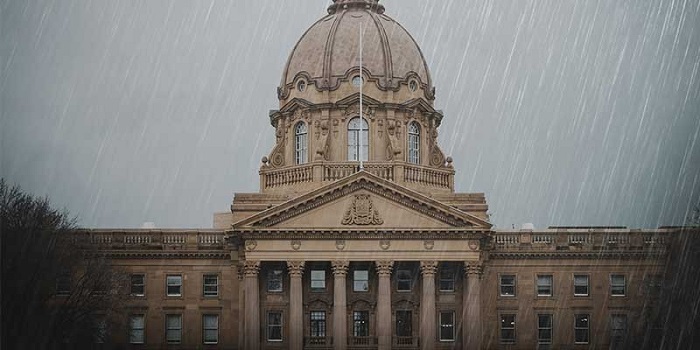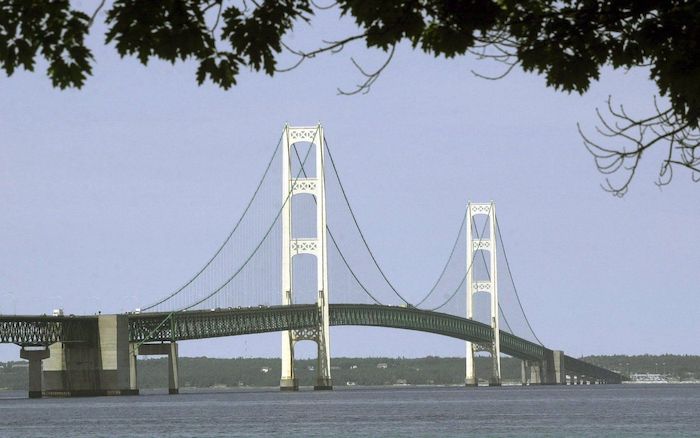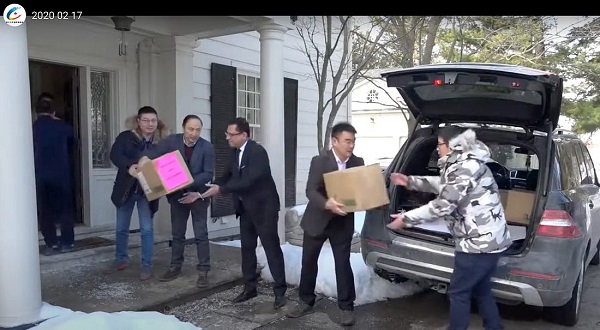Alberta
With spending restraint, Alberta can re-introduce a rainy-day fund worth $9.8 billion by 2025/26

From the Fraser Institute
It’s Time to Get Off the Resource Revenue Rollercoaster: Re-establishing the Alberta Sustainability Fund
With spending restraint, Alberta can re-introduce a rainy-day fund worth $9.8 billion by 2025/26 that could help insulate the province’s budget from swings in resource revenue, finds a new study published by the Fraser Institute, an independent, non-partisan Canadian public policy think-tank.
“Alberta has an ongoing fiscal problem fueled by volatile resource revenues, but reintroducing a rainy-day fund, based on the previously successful Alberta Sustainability Fund, would help get Alberta off this resource revenue rollercoaster and stabilize provincial finances for the long-term,” said Tegan Hill, associate director of Alberta policy at the Fraser Institute and co-author of There’s time to get off the resource revenue rollercoaster: Re-establishing the Alberta Sustainability Fund.
Alberta governments typically include all resource revenue in the budget, meaning that during periods of relatively high resource revenue, the province enjoys budget surpluses but faces pressure to increase spending, and when resource revenues decline, with comparatively high levels of spending, the province’s finances turn to deficits.
Consider that amid the windfall in resource revenue, in Budget 2023, the Alberta government increased cumulative spending by $10.1 billion from 2022/23 through 2024/25 compared to the 2022 Mid-Year Fiscal update just three months earlier.
Rather than continue to spend relatively high one-time resource revenue, the Alberta government can use this opportunity to stabilize provincial finances over the long-term.
By limiting resource revenue included the budget to a stable amount, it will thereby limit the amount of money available for annual spending. Any resource revenue above the set stable amount would be automatically saved in a rainy-day fund to be withdrawn to maintain that stable amount in years with relatively low resource revenue, thus, helping to avoid budget deficits.
The study calculates that with spending restraint Alberta can fund a rainy-day fund worth $9.8 billion by 2025/26.
“The rainy-day fund could be implemented all while still maintaining a balanced budget for Alberta,” Hill said.

Summary
- Alberta’s volatile resource revenues are fueling its ongoing fiscal problem. The provincial government typically includes all resource revenue in its budget. When resource revenue is relatively high, the province enjoys budget surpluses but faces pressure to increase spending; when resource revenues drop, spending remains high and the province turns to deficits.
- Despite efforts to better manage Alberta’s finances, the Smith government is largely repeating past mistakes by increasing spending during a period of relatively high resource revenue.
- In the 2022 mid-year update, the Smith government increased the plan for nominal program spending from Budget 2022 every year from 2022/23 through 2024/25 for a cumulative increase of $5.9 billion. In Budget 2023, the Smith government increased the plan further with a cumulative increase of $10.1 billion from 2022/23 through 2024/25 compared to the 2022 mid-year update.
- Rather than spend all of the resource revenue in years when it is relatively high, the Alberta government should use this opportunity to stabilize provincial finances over the long-term by re-introducing a rainy-day account based on the earlier Alberta Sustainability Fund (ASF).
- To do so, it would limit the resource revenue included the budget to a stable amount, thereby limiting the amount of money available for annual spending. Any resource revenue above the set stable amount would be automatically saved in the ASF to be withdrawn to maintain that stable amount in years with relatively low resource revenue. The government could implement the ASF while maintaining a balanced budget and without an annual reduction in nominal spending.
- Based on 2023 budget projections, with spending restraint, the provincial government could re-introduce an ASF worth $9.8 billion by 2025/26.
Authors:
Alberta
Made in Alberta! Province makes it easier to support local products with Buy Local program

Show your Alberta side. Buy Local. |
When the going gets tough, Albertans stick together. That’s why Alberta’s government is launching a new campaign to benefit hard-working Albertans.
Global uncertainty is threatening the livelihoods of hard-working Alberta farmers, ranchers, processors and their families. The ‘Buy Local’ campaign, recently launched by Alberta’s government, encourages consumers to eat, drink and buy local to show our unified support for the province’s agriculture and food industry.
The government’s ‘Buy Local’ campaign encourages consumers to buy products from Alberta’s hard-working farmers, ranchers and food processors that produce safe, nutritious food for Albertans, Canadians and the world.
“It’s time to let these hard-working Albertans know we have their back. Now, more than ever, we need to shop local and buy made-in-Alberta products. The next time you are grocery shopping or go out for dinner or a drink with your friends or family, support local to demonstrate your Alberta pride. We are pleased tariffs don’t impact the ag industry right now and will keep advocating for our ag industry.”
Alberta’s government supports consumer choice. We are providing tools to help folks easily identify Alberta- and Canadian-made foods and products. Choosing local products keeps Albertans’ hard-earned dollars in our province. Whether it is farm-fresh vegetables, potatoes, honey, craft beer, frozen food or our world-renowned beef, Alberta has an abundance of fresh foods produced right on our doorstep.
Quick facts
- This summer, Albertans can support local at more than 150 farmers’ markets across the province and meet the folks who make, bake and grow our food.
- In March 2023, the Alberta government launched the ‘Made in Alberta’ voluntary food and beverage labelling program to support local agriculture and food sectors.
- Through direct connections with processors, the program has created the momentum to continue expanding consumer awareness about the ‘Made in Alberta’ label to help shoppers quickly identify foods and beverages produced in our province.
- Made in Alberta product catalogue website
Related information
Alberta
Province to expand services provided by Alberta Sheriffs: New policing option for municipalities

Expanding municipal police service options |
Proposed amendments would help ensure Alberta’s evolving public safety needs are met while also giving municipalities more options for local policing.
As first announced with the introduction of the Public Safety Statutes Amendment Act, 2024, Alberta’s government is considering creating a new independent agency police service to assume the police-like duties currently performed by Alberta Sheriffs. If passed, Bill 49 would lay additional groundwork for the new police service.
Proposed amendments to the Police Act recognize the unique challenges faced by different communities and seek to empower local governments to adopt strategies that effectively respond to their specific safety concerns, enhancing overall public safety across the province.
If passed, Bill 49 would specify that the new agency would be a Crown corporation with an independent board of directors to oversee its day-to-day operations. The new agency would be operationally independent from the government, consistent with all police services in Alberta. Unlike the Alberta Sheriffs, officers in the new police service would be directly employed by the police service rather than by the government.
“With this bill, we are taking the necessary steps to address the unique public safety concerns in communities across Alberta. As we work towards creating an independent agency police service, we are providing an essential component of Alberta’s police framework for years to come. Our aim is for the new agency is to ensure that Albertans are safe in their communities and receive the best possible service when they need it most.”
Additional amendments would allow municipalities to select the new agency as their local police service once it becomes fully operational and the necessary standards, capacity and frameworks are in place. Alberta’s government is committed to ensuring the new agency works collaboratively with all police services to meet the province’s evolving public safety needs and improve law enforcement response times, particularly in rural communities. While the RCMP would remain the official provincial police service, municipalities would have a new option for their local policing needs.
Once established, the agency would strengthen Alberta’s existing policing model and complement the province’s current police services, which include the RCMP, Indigenous police services and municipal police. It would help fill gaps and ensure law enforcement resources are deployed efficiently across the province.
Related information
-

 Daily Caller1 day ago
Daily Caller1 day agoTrump Executive Orders ensure ‘Beautiful Clean’ Affordable Coal will continue to bolster US energy grid
-

 2025 Federal Election1 day ago
2025 Federal Election1 day agoBREAKING from THE BUREAU: Pro-Beijing Group That Pushed Erin O’Toole’s Exit Warns Chinese Canadians to “Vote Carefully”
-

 Business1 day ago
Business1 day agoChina, Mexico, Canada Flagged in $1.4 Billion Fentanyl Trade by U.S. Financial Watchdog
-

 2025 Federal Election2 days ago
2025 Federal Election2 days agoTucker Carlson Interviews Maxime Bernier: Trump’s Tariffs, Mass Immigration, and the Oncoming Canadian Revolution
-

 COVID-1922 hours ago
COVID-1922 hours agoTamara Lich and Chris Barber trial update: The Longest Mischief Trial of All Time continues..
-

 2025 Federal Election1 day ago
2025 Federal Election1 day agoAllegations of ethical misconduct by the Prime Minister and Government of Canada during the current federal election campaign
-

 Energy23 hours ago
Energy23 hours agoStraits of Mackinac Tunnel for Line 5 Pipeline to get “accelerated review”: US Army Corps of Engineers
-

 Business2 days ago
Business2 days agoDOGE Is Ending The ‘Eternal Life’ Of Government








